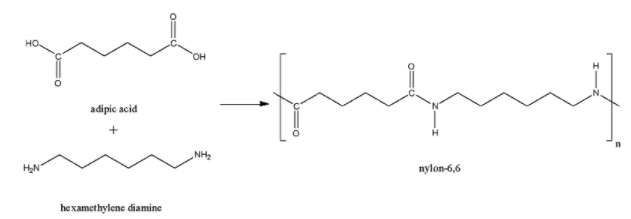
Answer
471.9k+ views
Hint:
We know that polymer of polyamide is made up of monomer units in which amide group is present. Amide group is the $CO-N{{H}_{2}}$and the polyamide contains the $CO-NH$ linkage. Check all options whether there is amide group present or not.
Complete step by step solution:
The Nylon-6,10 is a polymer made up of the monomer units hexamethylenediamine and sebacoyl chloride. In this polymer, there is $CO-NH$ (amide) linkage and therefore, it is a polyamide polymer.

The Nylon-6,6 is a polymer made up of the monomer units hexamethylenediamine and adipic acid. Here also, the acid group and amine group joined together to form the amide linkage. So, Nylon-6,6 is also a polyamide polymer.

Nylon-5 is formed from the monomer units of pentamethylene diamine and sebacic acid. Here also, there is an amide linkage present. So, Nylon-5 is a polyamide polymer.

The perlon-U is also known as polyurethane also formed through the polyamide linkage after the combination of 1,4-butanediol and 1,6-hexamethylene diisocyanate. So, perlon-U is also a polyamide polymer.

Here, in each example, we can see that at least one $CO-NH$ bond.
Therefore, Nylon-6,10, Nylon-6,6, Nylon-5 and Perlon-U are polyamide polymers. So, the correct option is (a), (b), (c) and (d).
Note:
The name Nylon-6,10 suggests that one monomer unit of Nylon contains 6 carbons and the other monomer units contains 10 carbons. Similarly, Nylon-6,6 contains monomer units hexamethylenediamine and adipic acids, both having 6 carbon atoms.
We know that polymer of polyamide is made up of monomer units in which amide group is present. Amide group is the $CO-N{{H}_{2}}$and the polyamide contains the $CO-NH$ linkage. Check all options whether there is amide group present or not.
Complete step by step solution:
The Nylon-6,10 is a polymer made up of the monomer units hexamethylenediamine and sebacoyl chloride. In this polymer, there is $CO-NH$ (amide) linkage and therefore, it is a polyamide polymer.

The Nylon-6,6 is a polymer made up of the monomer units hexamethylenediamine and adipic acid. Here also, the acid group and amine group joined together to form the amide linkage. So, Nylon-6,6 is also a polyamide polymer.

Nylon-5 is formed from the monomer units of pentamethylene diamine and sebacic acid. Here also, there is an amide linkage present. So, Nylon-5 is a polyamide polymer.

The perlon-U is also known as polyurethane also formed through the polyamide linkage after the combination of 1,4-butanediol and 1,6-hexamethylene diisocyanate. So, perlon-U is also a polyamide polymer.

Here, in each example, we can see that at least one $CO-NH$ bond.
Therefore, Nylon-6,10, Nylon-6,6, Nylon-5 and Perlon-U are polyamide polymers. So, the correct option is (a), (b), (c) and (d).
Note:
The name Nylon-6,10 suggests that one monomer unit of Nylon contains 6 carbons and the other monomer units contains 10 carbons. Similarly, Nylon-6,6 contains monomer units hexamethylenediamine and adipic acids, both having 6 carbon atoms.
Recently Updated Pages
Fill in the blanks with suitable prepositions Break class 10 english CBSE

Fill in the blanks with suitable articles Tribune is class 10 english CBSE

Rearrange the following words and phrases to form a class 10 english CBSE

Select the opposite of the given word Permit aGive class 10 english CBSE

Fill in the blank with the most appropriate option class 10 english CBSE

Some places have oneline notices Which option is a class 10 english CBSE

Trending doubts
Fill the blanks with the suitable prepositions 1 The class 9 english CBSE

How do you graph the function fx 4x class 9 maths CBSE

When was Karauli Praja Mandal established 11934 21936 class 10 social science CBSE

Which are the Top 10 Largest Countries of the World?

What is the definite integral of zero a constant b class 12 maths CBSE

Why is steel more elastic than rubber class 11 physics CBSE

Distinguish between the following Ferrous and nonferrous class 9 social science CBSE

The Equation xxx + 2 is Satisfied when x is Equal to Class 10 Maths

Differentiate between homogeneous and heterogeneous class 12 chemistry CBSE




